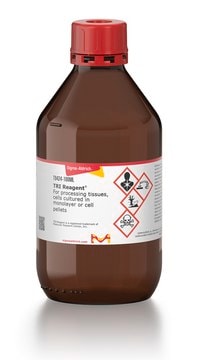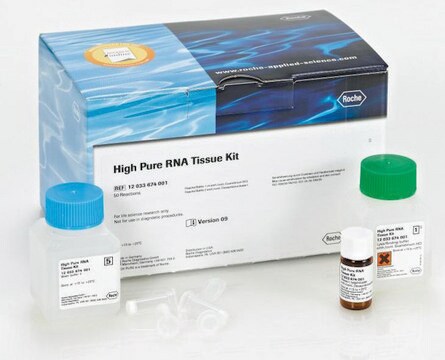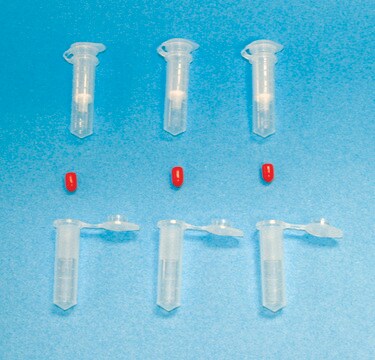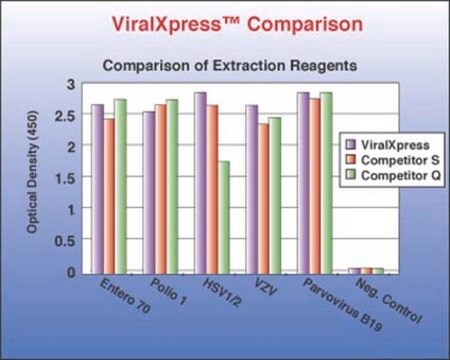おすすめの製品
詳細
CHEMICON′s EX-WAX DNA Extraction Kit is intended to extract DNA from paraffin-embedded tissue fixed in 10% Formalin or non-crosslinking fixatives. DNA extracted by this kit is suitable for amplification by PCR.
Limitations:
The quality of extracted DNA is directly related to the quality of the embedded tissue. Harsh or extended fixation will adversely affect the results.
Summary and Principle
The EX-WAX DNA Extraction Kit is qualified on paraffin-embedded mammalian tissues fixed in 10% Formalin or non-crosslinking fixative. DNA is made accessible by protein digestion. DNA is solubilized, while digested proteins are "salted out" and spun to the bottom of the tube. DNA is precipitated, dried under vacuum, and resuspended. Once in solution, the DNA is suitable for amplification by PCR.
Warnings and Precautions
1. Wear gloves when isolating and handling DNA to minimize the activity of endogenous nucleases. Use autoclaved pipette tips and 1.5 ml microcentrifuge tubes for additional protection against nucleases.
2. Volumes are optimized for five 5 μm thick sections.
3. Qualified on tissue fixed in 10% Formalin or non-crosslinking fixative.
4. Not recommended for use with fresh, frozen tissues.
Limitations:
The quality of extracted DNA is directly related to the quality of the embedded tissue. Harsh or extended fixation will adversely affect the results.
Summary and Principle
The EX-WAX DNA Extraction Kit is qualified on paraffin-embedded mammalian tissues fixed in 10% Formalin or non-crosslinking fixative. DNA is made accessible by protein digestion. DNA is solubilized, while digested proteins are "salted out" and spun to the bottom of the tube. DNA is precipitated, dried under vacuum, and resuspended. Once in solution, the DNA is suitable for amplification by PCR.
Warnings and Precautions
1. Wear gloves when isolating and handling DNA to minimize the activity of endogenous nucleases. Use autoclaved pipette tips and 1.5 ml microcentrifuge tubes for additional protection against nucleases.
2. Volumes are optimized for five 5 μm thick sections.
3. Qualified on tissue fixed in 10% Formalin or non-crosslinking fixative.
4. Not recommended for use with fresh, frozen tissues.
アプリケーション
Preparation of Reagents
Protein Digesting Enzyme Solution
Add 1.25 ml of Sterile Distilled Water (supplied) to the vial of Protein Digesting Enzyme powder. Mix thoroughly. Store unused solution at -15°C to -25°C.
Extraction Procedure
1. Cut the tissue sections 5 μm thick. Use 3-5 sections for each extraction.
2. Cut away excess paraffin and place sections in a 1.5 ml tube. Spin briefly to pellet sections.
3. Add 1 ml of fresh 100% ethanol (room temperature) and gently vortex for 15 seconds.
4. Spin for 3 minutes in a microcentrifuge at 12,000 rpm.
5. Remove ethanol and dry pellet in a vacuum concentrator or at 60°C for 10 minutes with the cap open. If residual ethanol is still present, dry for another 10 minutes.
6. Add 150 μl of Digestion Solution and 50 μl of Protein Digesting Enzyme Solution to the tube and mix by stirring. Use the end of the micropipettor tip and physically mix the pellet into the solution. Do not pipette up and down (pellet will not dissolve).
7. Incubate for 4 hours to overnight at 50°C.
8. Add 100 μl of Extraction Solution and mix by inversion (at least 3 times) for 15 seconds. Over-mixing will excessively shear the DNA.
9. Spin in a microcentrifuge for 10 minutes at 12,000 rpm. Remove the supernatant and place it in a fresh 1.5 ml tube. This is accomplished by carefully poking the pipette tip through the paraffin layer on top and withdrawing the supernatant, leaving the paraffin and the pellet behind (see Figure 1). If small amounts of paraffin are removed with the supernatant, they will not affect the extraction.
10. Add 150 μl of Precipitation Solution to the supernatant, invert the tube 3 times, then add 900 μl of ice cold (-20°C) 100% ethanol. Cap the tube and invert several times to mix.
11. Place at -20°C for at least 1 hour.
12. Spin in a microcentrifuge for 10 minutes at 12,000 rpm. Discard the supernatant.
13. Dry the pellet in a vacuum concentrator or at 60°C with the cap open for 10 minutes. If residual ethanol is still present, dry for another 10 minutes.
14. Add 50 μl of Resuspension Solution and incubate for 1 hour at 50°C in a water bath.
15. Use 1 μl of resuspended DNA for each PCR reaction and run appropriate PCR controls.
Troubleshooting
1. When resuspending the DNA in Resuspension Solution, do not heat the DNA higher than 55°C. This will cause degradation of the DNA.
2. If the PCR reaction fails, check for the presence and quality of the DNA as follows: Run 10 μl of extracted sample DNA and molecular weight markers on a 0.8% agarose minigel using a 3 mm (width) toothed comb. Run the bromophenol blue dye front approximately 5 cm into the gel. If no sample DNA is observed, try adding 10-40 μl of sample DNA to the PCR reaction or extract a greater number of tissue sections. If the amount of tissue in the block is small, extract more sections, but if the amount of tissue is very large, you may want to try less.
Protein Digesting Enzyme Solution
Add 1.25 ml of Sterile Distilled Water (supplied) to the vial of Protein Digesting Enzyme powder. Mix thoroughly. Store unused solution at -15°C to -25°C.
Extraction Procedure
1. Cut the tissue sections 5 μm thick. Use 3-5 sections for each extraction.
2. Cut away excess paraffin and place sections in a 1.5 ml tube. Spin briefly to pellet sections.
3. Add 1 ml of fresh 100% ethanol (room temperature) and gently vortex for 15 seconds.
4. Spin for 3 minutes in a microcentrifuge at 12,000 rpm.
5. Remove ethanol and dry pellet in a vacuum concentrator or at 60°C for 10 minutes with the cap open. If residual ethanol is still present, dry for another 10 minutes.
6. Add 150 μl of Digestion Solution and 50 μl of Protein Digesting Enzyme Solution to the tube and mix by stirring. Use the end of the micropipettor tip and physically mix the pellet into the solution. Do not pipette up and down (pellet will not dissolve).
7. Incubate for 4 hours to overnight at 50°C.
8. Add 100 μl of Extraction Solution and mix by inversion (at least 3 times) for 15 seconds. Over-mixing will excessively shear the DNA.
9. Spin in a microcentrifuge for 10 minutes at 12,000 rpm. Remove the supernatant and place it in a fresh 1.5 ml tube. This is accomplished by carefully poking the pipette tip through the paraffin layer on top and withdrawing the supernatant, leaving the paraffin and the pellet behind (see Figure 1). If small amounts of paraffin are removed with the supernatant, they will not affect the extraction.
10. Add 150 μl of Precipitation Solution to the supernatant, invert the tube 3 times, then add 900 μl of ice cold (-20°C) 100% ethanol. Cap the tube and invert several times to mix.
11. Place at -20°C for at least 1 hour.
12. Spin in a microcentrifuge for 10 minutes at 12,000 rpm. Discard the supernatant.
13. Dry the pellet in a vacuum concentrator or at 60°C with the cap open for 10 minutes. If residual ethanol is still present, dry for another 10 minutes.
14. Add 50 μl of Resuspension Solution and incubate for 1 hour at 50°C in a water bath.
15. Use 1 μl of resuspended DNA for each PCR reaction and run appropriate PCR controls.
Troubleshooting
1. When resuspending the DNA in Resuspension Solution, do not heat the DNA higher than 55°C. This will cause degradation of the DNA.
2. If the PCR reaction fails, check for the presence and quality of the DNA as follows: Run 10 μl of extracted sample DNA and molecular weight markers on a 0.8% agarose minigel using a 3 mm (width) toothed comb. Run the bromophenol blue dye front approximately 5 cm into the gel. If no sample DNA is observed, try adding 10-40 μl of sample DNA to the PCR reaction or extract a greater number of tissue sections. If the amount of tissue in the block is small, extract more sections, but if the amount of tissue is very large, you may want to try less.
構成
Sufficient reagents to perform 20 DNA extractions containing three to five 5 μm thick tissue sections per extraction.
90442 Sterile Distilled Water (clear) 1.25 ml Room temp.
90443 Digestion Solution 3.0 ml Room temp.
90444 Extraction Solution 2.0 ml Room temp.
90445 Precipitation Solution 3.0 ml Room temp.
90446 Resuspension Solution 2.0 ml Room temp.
90447 Protein Digesting 25 mg -15 to -25°C
Enzyme (Powder)
90442 Sterile Distilled Water (clear) 1.25 ml Room temp.
90443 Digestion Solution 3.0 ml Room temp.
90444 Extraction Solution 2.0 ml Room temp.
90445 Precipitation Solution 3.0 ml Room temp.
90446 Resuspension Solution 2.0 ml Room temp.
90447 Protein Digesting 25 mg -15 to -25°C
Enzyme (Powder)
法的情報
CHEMICON is a registered trademark of Merck KGaA, Darmstadt, Germany
免責事項
Unless otherwise stated in our catalog or other company documentation accompanying the product(s), our products are intended for research use only and are not to be used for any other purpose, which includes but is not limited to, unauthorized commercial uses, in vitro diagnostic uses, ex vivo or in vivo therapeutic uses or any type of consumption or application to humans or animals.
シグナルワード
Danger
危険有害性情報
危険有害性の分類
Eye Irrit. 2 - Resp. Sens. 1 - Skin Irrit. 2 - STOT SE 3
ターゲットの組織
Respiratory system
保管分類コード
10 - Combustible liquids
適用法令
試験研究用途を考慮した関連法令を主に挙げております。化学物質以外については、一部の情報のみ提供しています。 製品を安全かつ合法的に使用することは、使用者の義務です。最新情報により修正される場合があります。WEBの反映には時間を要することがあるため、適宜SDSをご参照ください。
毒物及び劇物取締法
キットコンポーネントの情報を参照してください
PRTR
キットコンポーネントの情報を参照してください
消防法
キットコンポーネントの情報を参照してください
労働安全衛生法名称等を表示すべき危険物及び有害物
キットコンポーネントの情報を参照してください
労働安全衛生法名称等を通知すべき危険物及び有害物
キットコンポーネントの情報を参照してください
カルタヘナ法
キットコンポーネントの情報を参照してください
Jan Code
キットコンポーネントの情報を参照してください
試験成績書(COA)
製品のロット番号・バッチ番号を入力して、試験成績書(COA) を検索できます。ロット番号・バッチ番号は、製品ラベルに「Lot」または「Batch」に続いて記載されています。
V Vaccaro et al.
BioMed research international, 2014, 351252-351252 (2014-05-31)
No established chemotherapeutic regimen exists for the treatment of recurrent malignant gliomas (rMGs). Herein, we report the activity and safety results of the bevacizumab (B) plus fotemustine (FTM) combination for the treatment of rMGs. An induction phase consisted of B
Ilse Vlassenbroeck et al.
The Journal of molecular diagnostics : JMD, 10(4), 332-337 (2008-06-17)
Epigenetic silencing of the DNA repair protein O(6)-methylguanine-DNA methyltransferase (MGMT) by promoter methylation predicts successful alkylating agent therapy, such as with temozolomide, in glioblastoma patients. Stratified therapy assignment of patients in prospective clinical trials according to tumor MGMT status requires
Alessandra Fabi et al.
BMC cancer, 9, 101-101 (2009-04-02)
In recurrent malignant gliomas (MGs), a high rate of haematological toxicity is observed with the use of fotemustine at the conventional schedule (100 mg/m(2) weekly for 3 consecutive weeks followed by triweekly administration after a 5-week rest period). Also, the
Roger Stupp et al.
Journal of clinical oncology : official journal of the American Society of Clinical Oncology, 28(16), 2712-2718 (2010-05-05)
Invasion and migration are key processes of glioblastoma and are tightly linked to tumor recurrence. Integrin inhibition using cilengitide has shown synergy with chemotherapy and radiotherapy in vitro and promising activity in recurrent glioblastoma. This multicenter, phase I/IIa study investigated
Monika E Hegi et al.
The New England journal of medicine, 352(10), 997-1003 (2005-03-11)
Epigenetic silencing of the MGMT (O6-methylguanine-DNA methyltransferase) DNA-repair gene by promoter methylation compromises DNA repair and has been associated with longer survival in patients with glioblastoma who receive alkylating agents. We tested the relationship between MGMT silencing in the tumor
ライフサイエンス、有機合成、材料科学、クロマトグラフィー、分析など、あらゆる分野の研究に経験のあるメンバーがおります。.
製品に関するお問い合わせはこちら(テクニカルサービス)








